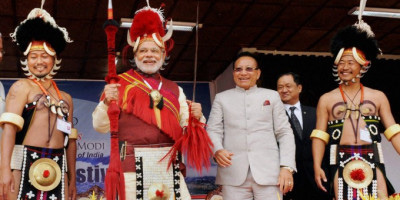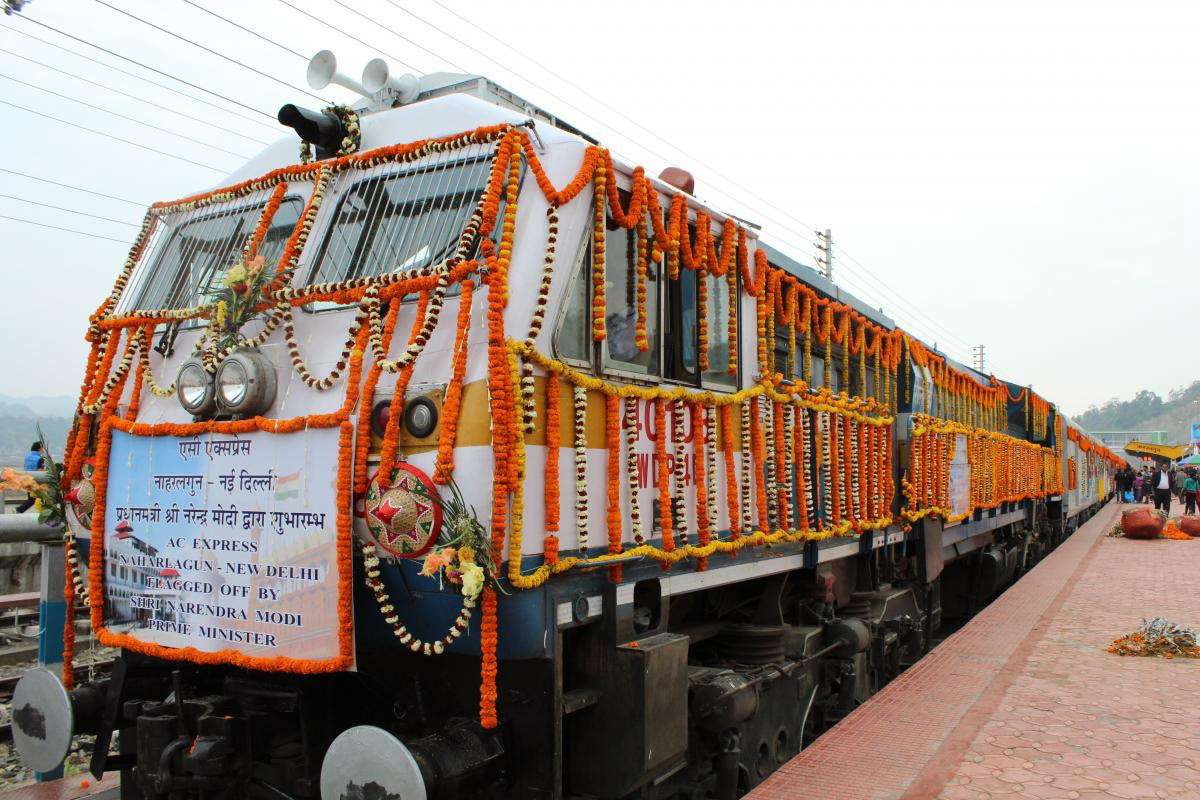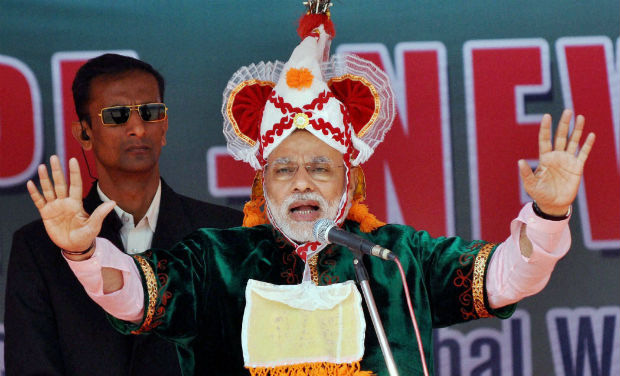North East obtained a special place in the country’s development agenda under the current NDA regime. Modi government from day one has put extra efforts to pace up the development work in the region. Under the Proactive Act East Policy, the Government aims not only to reduce the isolation of the region but also plans to make it India’s gateway to the South East Asian Countries. This was asserted by its mention in the then president Pranab Mukherjee’s address in February last year where the idea of development of North East as the “Ashta-lakshmi” was envisaged.
 The Prime ministers vision of Transformation of North East by Transportation is given a high priority. The issue of Connectivity is being unraveled by the major infrastructural boost. In the last three years, the centre has sanctioned 3800 km of national highways with an investment of over Rs 32,000 crores, of which more than 1200 km roads have already been laid. The Prime Minister who is spearheading the development in the NER, also promised that the union government would invest another 60,000 crore rupees under the SARD (Special Accelerated Road Development) Program and additional Rs 30,000 crores under the Bharatmala project in the next few years to come.
The Prime ministers vision of Transformation of North East by Transportation is given a high priority. The issue of Connectivity is being unraveled by the major infrastructural boost. In the last three years, the centre has sanctioned 3800 km of national highways with an investment of over Rs 32,000 crores, of which more than 1200 km roads have already been laid. The Prime Minister who is spearheading the development in the NER, also promised that the union government would invest another 60,000 crore rupees under the SARD (Special Accelerated Road Development) Program and additional Rs 30,000 crores under the Bharatmala project in the next few years to come.
Road connectivity projects are not only empowering the North East by generating large-scale employment opportunities to the people of the region but are also playing key role in facilitating the defense capabilities of the country. This region having high strategic importance, is being used to open doors for establishing strong relations with Southeast Asian countries. Some projects are also being backed by Japanese funding. Aimed at countering China’s ambitious OBOR Initiative, India hastened the South Asian Sub-Regional Economic Cooperation (SASEC) programme and is also working on a multitude of road and bridge projects to improve connectivity with Bangladesh, Nepal, Myanmar and Thailand.
 Rail connectivity for the region is vital considering the regular damage of roads accounting to severe weather conditions. In terms of rail connectivity, Suresh Prabhu will be remembered by the people of North East for delivering what other railway ministers before him could not. The situation of rail connectivity was so adverse that only one of the capital city of the north eastern states had a railway station until 2008, when Agartala became the second capital to have one. Projects of gauge conversion had also been started in the past but none were completed before 2014.
Rail connectivity for the region is vital considering the regular damage of roads accounting to severe weather conditions. In terms of rail connectivity, Suresh Prabhu will be remembered by the people of North East for delivering what other railway ministers before him could not. The situation of rail connectivity was so adverse that only one of the capital city of the north eastern states had a railway station until 2008, when Agartala became the second capital to have one. Projects of gauge conversion had also been started in the past but none were completed before 2014.
But within three years of the formation of this government, five of the north eastern states have been brought under the broad gauge map of the country. Today, no metre gauge line exists in the northeastern states, thanks to the conversion of over 900 kms of track to broad gauge in the last three years. Tripura also got its Rajdhani express last October. All the states of the region are now included in the broad gauge network, except for Sikkim which hasn’t seen any rail connectivity even after 70 years of Independence. More than 30 new trains including two freight trains have been added in the past few years alone. Work has also started on connecting the region with Bangladesh and Myanmar via rail in order to facilitate easy access to ports and to cut down the time and distance to Kolkata.
Of late, The Union Aviation Ministry has also been busy in the Northeast region. The government’s plans to add 19 new or underserved airports and 17 new heliports in the region under its aviation network. Plans are being laid out to connect the region not only with the country’s mainland but also with other South East Asian Countries. With bases in Shillong and Imphal, the Ministry of Development of North East Region is also planning to introduce a helicopter-based dispensary and OPD services in the far-flung areas of the region. This depicts the Government’s efforts to use all its means to push for better connectivity of the region.
Being blessed with pristine scenic beauty and profuse natural resources, the North East Region has attracted the trading community even in the pre-independence era. The Brahmaputra and the Barak rivers were the main conveyance systems through which the goods were transported to the port of Kolkata through undivided Bengal. However, the new political boundaries dealt a major blow to the then flourishing inland navigation systems and the region become disconnected and later turned into a region with a lot of hurdles in connectivity.
Lately, the government of India seem to renew its focus on developing the cost effective and environmental friendly inland navigation systems. Whereas only five waterways have been recognized as national waterways prior to 2016, the new national waterways Act of 2016 recognized 106 new waterways as National Waterways (NWs). Of these, prime attention is being given to the NW-2 which is 891 kms of Brahmaputra covering the entire length of Assam and NW-16, which is 121 kms of Barak river. The terms of the Indo-Bangladesh Protocol for Inland Water Transit and Trade (PIWTT) have also been modified enough to ease the connection of these waterways with Kolkata through Bangladesh. This includes the allowance of River Sea Vessels to carry huge amounts of cargo through the waters of Bangladesh. The central government is aptly following the principle of “Think Globally, Act Locally” by promoting the use of waterways.
Another sector which bolstered Government’s North East plan is the power sector. The region, with its huge hydro power potential of more than 58,000 MW could soon be the “Power House” to India. Sadly, only less than 2% of it has been exploited until 2016. The situation is currently improving as the region started feeding the rest of the country with 100s of MWs in 2017.
The region not only has the potential to generate a huge amount of hydro-power but also has a lot of scope to set up non conventional wind and solar power plants as well as conventional gas and coal power plants. The power potential of the region is so huge that it will not only supply power to the rest of the country but also satisfy the power needs of neighboring countries – Bangladesh and Myanmar, in turn leading to good relations with them. The fruits of the government’s efforts in the power sector are still awaited.
The Tourism Sector which is a major revenue source for the NE region is the biggest gainer considering the infrastructural push by the Government. Enhanced air connectivity will attract tourists from other states and also people from all over the world to explore the beauty of the region. Rail connectivity would help all weather tourism and Road connectivity would increase Trans – Border tourism. River-based tourism is yet another prospect that the region has. Particularly with India and Bangladesh signing a MoU on operating cross-border river cruises along protocol routes, there has already been some movement in this direction.
Apart from all this, the government’s support to the ventures by the locals through the North East Venture Fund is receiving a huge praise from the local youth. This fund stands as a great support to local entrepreneurs working on areas such as horticulture, food processing, handicrafts and ITES. Initiatives such as these demonstrates the central government’s focus on development of the region.
Politically, the region has been for long considered as a bastion of congress. But with the special focus on creation of “Ashtalakshmi” under the Act-East Policy, BJP is reaching out to the people of North East with a positive development agenda. The effects of that development narrative was reflected in the assembly polls of Assam, Arunachal and Manipur that were held post the formation of the government at the centre in 2014. The recent assembly election results in Tripura, Nagaland and Meghalaya is a resounding endorsement of the developmental vision for the region that Prime Minister Modi has put forward
Apart from developmental initiatives, acts such as the proactive intervention in Doklam and hosting all ASEAN leaders at Republic Day Celebrations have created a sense of pride and instilled faith among the masses of this region in PM Modi’s vision of Act East Policy. The Act and not just the Look of the present regime towards India’s northeast has huge potential to transform the long neglected region into a vibrant hub of possibilities.
(The Author is BJP Official State Spokesperson of Telangana, an Economist and Director, Center for Leadership and Governance)
(The views expressed are the author's own and do not necessarily reflect the position of the organisation)

